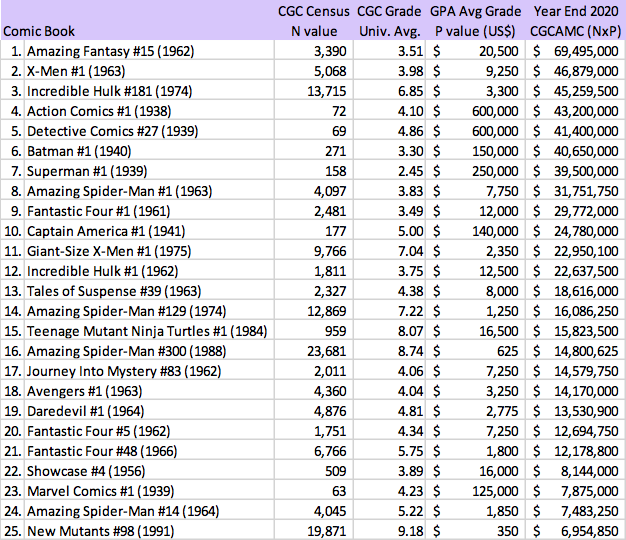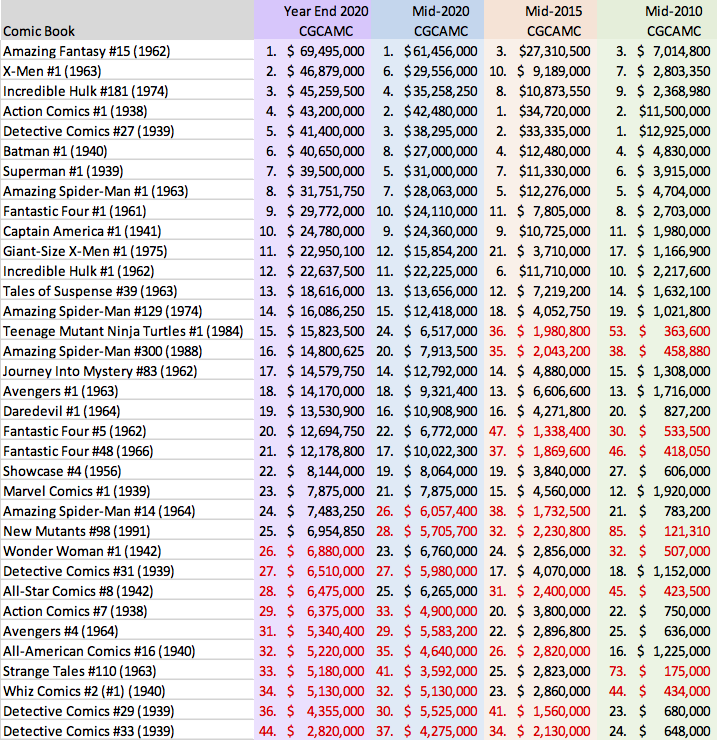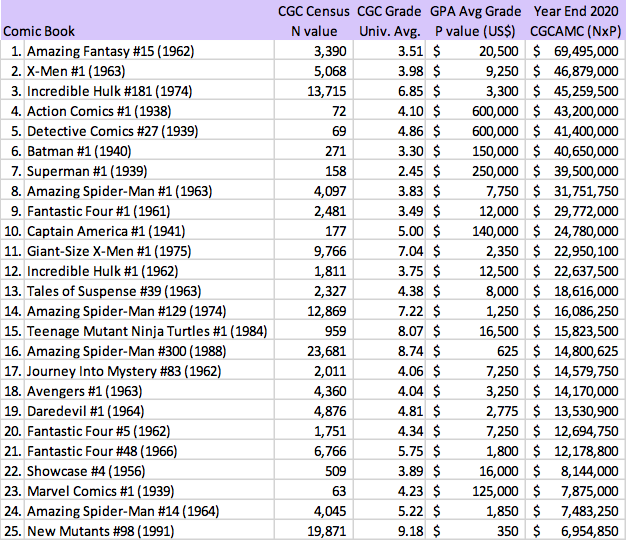CGC Average Market Capitalization (CGCAMC): 2020 Year In Review
This is the third article on the topic of CGC Average Market Capitalization (CGCAMC). The introductory article was published in November 2020 at this link. < https://comics.gpanalysis.com/... > The second article was published December 2020 at this link. < https://comics.gpanalysis.com/... >
As a brief review, the CGCAMC is the calculation of a total dollar amount for the number of CGC graded copies for a comic book multiplied by the average price for the average CGC grade of that comic book. It does not represent the total value of all copies of a comic book, but it does provide a result that allows comparison between comic books which may be very different values with very different numbers of copies graded.
The application of the CGCAMC calculation as of mid-2020 produced a “Top 25 CGCAMC List” as shown below. The Top 25 CGCAMC values span fifty years from 1938 to 1988, showing that the Golden Age may always dominate individual sale prices, but any era has the potential to reach the “biggest books” list when it comes to the CGCAMC calculation.

The total dollars represented by the Top 25 CGCAMC books for mid-2020: $498,942,550
2020 Year-End Update
Updating the CGCAMC calculation for the year end of 2020, there are a number of changes that reflect the significant activity in the market during the prior year.

The total dollars represented by the Top 25 CGCAMC books for Year End 2020: $621,212,525
The (New?) Big Three
The Top 3 CGCAMC comic books for Year End 2020 are Amazing Fantasy #15 (1962), X-Men #1 (1963), and Incredible Hulk #181 (1974). This is a significant change from the prior 2020, 2015, and 2010 Top 25 CGCAMC lists, moving Action Comics #1 (1938) and Detective Comics #27 (1939) out of the Top 3 for the first time.
There are at least two possibilities for future CGCAMC calculations related to the traditional “Big Three” books. One possibility is that X-Men #1 and Incredible Hulk #181 are only temporary holders of spots in the Top 3, and the “Big Two” (apart from Amazing Fantasy #15) will return to the Top 3 very soon. Another possibility is that the very low number of copies in the CGC Census for Action Comics #1 (1938) and Detective Comics #27 (1939) and the other Golden Age key issues from the 1930s and 1940s will continue to be a hindrance when compared to the higher CGC Census populations for Silver Age keys of the 1960s in the CGCAMC calculation.
Between mid-2020 and year end 2020, the total dollars represented by the Top 25 CGCAMC books increased 24.5% from $498,942,550 to $621,212,525. From 2015 to 2020, the increase was 107% from $240,200,200 to $498,942,550. That is an average of about 20% per year from mid-2015 to mid-2020, contrasted with a 24.5% increase in just six months during 2020.
Side-By-Side Comparison
A side-by-side listing of all books to make the Top 25 CGCAMC lists in 2020 or the 2015 and 2010 lists presented in the prior article results in the following table sorted by the mid-2020 CGCAMC values:

Entering the Top 25 CGCAMC list for Year End 2020 are Amazing Spider-Man #14 (1964) and New Mutants #98 (1991) in 24th and 25th positions. New Mutants #98 also has the greatest rise between 2010 and year end 2020, moving from 85th position in 2010 to 25th position at year end 2020, becoming the first book from the 1990s in the Top 25, and also the first book in the Top 25 CGCAMC calculation with an average condition value under $500. This may either be a reflection of a temporary state of the market or a signal of the “changing of the guard” with Amazing Spider-Man #300 also rising in the Top 25 despite an average condition value of just $625.
The greatest fall in position from 2010 to 2020 occurred with Detective Comics #33 (1939), falling from 24th position in 2010 to 44th position at year end 2020. It should be noted that a single sale is often all that is needed to greatly change the positions of books which are rarely sold, however, the population of the CGC Census continues to grow for more recent comics with much higher supply. As a result, Action Comics #1 and Detective Comics #27 could return to the Top 3 quickly and easily, but for the moment, Amazing Fantasy #15 (1962) is leaving all other books behind in the CGCAMC calculation.
CGCAMC As A Measure Of The Market
The traditional Top Value list of comic books is heavily weighted by the Golden Age key issues, and they are definitely among the most valuable comic books when sold one at time. That type of traditional Top 25 by value is certainly eye-catching, and many books on that list are quite important despite (or perhaps, because of) their very low CGC Census population. But the difference between one sale of a $20,000 book and 200 sales of a $1,000 book should be obvious. $20,000 is exciting for one book sale, or for a discovery of a $20,000 comic book in a forgotten box in an attic, but those 200 books of $1,000 each are ten times more market at $200,000, and two hundred times more book activity.
Sorted by the traditional method of individual book prices only, for CGC average condition, the CGCAMC Top 25 would be hard to interpret:

First of all, this type of sorted list is missing so many Golden Age books with high individual values that would fall between $20,000 and $125.000. Additionally, this sorting puts Amazing Fantasy #15 into the 7th position, which would certainly be lower if other Golden Age key issues were included. If there are 30 other books with higher individual average condition values than $20,000, does that mean Amazing Fantasy #15 deserved to be recognized as only the 37th most important comic book in the market?
Does Amazing Spider-Man #300 deserve to be ignored completely if all the hundreds (or thousands) of other average condition comic books of all ages worth more than $625 were also included in this list? The traditional Top Values sorted list doesn’t count the total dollars in the collective market. The other tradition of keeping separate Top Value lists by their ages and genres doesn’t put those market puzzle pieces together to form the big picture. Quality (demand by price) is important, but so is quantity (supply by book).
This three-part article series has explored CGCAMC as a calculation which may be an effective tool for evaluating the well-establish CGC graded comic book market, allowing a “level playing field” for key issues from any age. Combining the supply with the demand as calculated in CGCAMC provides a broader view of the market, allowing Amazing Spider-Man #1 (1963) and Amazing Spider-Man #300 (1988) to rank only eight positions apart within the Top 25 for CGCAMC, despite the vast differences in their individual book values, their ages, and their CGC census counts. The comic book market is described more thoroughly by combining the highest price individual issues with the supply for those books.

This simple CGCAMC calculation (N times P, or number-times-price) from the table above allows a sorted view of the collective comic book market, allowing comics of different ages and genres to be compared directly, without needing to calculate 25 different grade values, without needing to estimate the percentage of restoration, without needing to guess how many more copies haven’t been CGC graded, and without putting a $20,000 comic with 100 CGC graded copies ahead of a $350 comic with nearly 20,000 graded copies.
The market is much more than high individual book prices, as eye-catching as they might be.
About the Author
 |
Greg Holland has collected comic books for over 30 years and has been the administrator of the CGC Census Analysis website since 2003, currently located at CGCdata.com. He is the 1999 founder of the ValiantComics.com website and the 2004 ValiantFans.com message board. Dr. Holland holds a Ph.D. in information quality from the University of Arkansas at Little Rock and has held data science positions as research director, analyst, and administrator for government, corporations, and university. Active on the CGC Forums as ‘valiantman’ since 2002, he is also a 15+ year advisor to the Overstreet Comic Book Price Guide and contributor to later editions of the Standard Catalog of Comic Books. Greg resides in Arkansas, USA, with his wife of 23 years and their daughter. |
Related news
24 Oct 2022
Canadian Price Variants (CPVs) and GPAnalysis.com Recorded Sales
With Canadian Price Variants recorded in GPAnalysis.com for decades, what can the data tell us about rarity and value when comparing against direct editions?
Read more26 May 2022
CGC Census - A Game for the Thousandth Collector
Imagine a game where 1,000 lucky comic collectors are awarded the best available copies of comic books from the CGC Census. Where would ticket #1,000 be for the earliest appearances of favorite characters? Some winning books may surprise you.
Read more